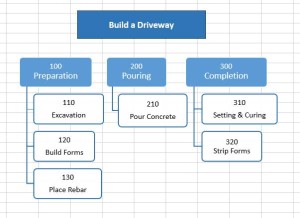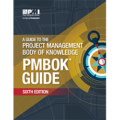
If there is only one foundational part of project management, it would have to be breaking down the project into manageable parts. Those parts are called phases and tasks. Everything else is built upon that foundation, so it should not be taken lightly. Although it seems trivial, it is one of the most important parts of a project manager’s job.
Example Task List
In the Project Management Body of Knowledge (PMBOK), the output of the Define Activities process is a Task List, also called Activity List. The following might be a typical Task List for a driveway construction project:
| Task List | ||
| Task No. | Name | Dependencies |
|---|---|---|
| 110 | Excavation | |
| 120 | Build Forms | 110 |
| 130 | Place Rebar | 110 |
| 210 | Pour Concrete | 120, 130 |
| 310 | Setting & Curing | 210 |
| 320 | Strip Forms | 310 |
A graphical style is sometimes helpful, but not a necessity:

Activity Attributes
The activity list also contains activity attributes, which identify meta-level information about the task. For example, there could be a column called “Subcontractor”:
| Task List | |||
| Task No. | Name | Dependencies | Subcontractor |
|---|---|---|---|
| 110 | Excavation | ||
| 120 | Build Forms | 110 | |
| 130 | Place Rebar | 110 | Jon’s Concrete |
| 210 | Pour Concrete | 120, 130 | Jon’s Concrete |
| 310 | Setting & Curing | 210 | |
| 320 | Strip Forms | 310 | |
How to Develop the Task List
In an ideal world, you would completely define all of the project work during the planning phase. But since this is not realistic, you must get as close as possible, as time and money allows.
The activities should be defined based on the following criteria:
- The tasks should be of a size and complexity that allow them to be reliably estimated. For example, it is difficult to estimate the cost for the task concrete. That’s why it’s divided into the sub-tasks pour concrete, setting & curing, etc. which can be reliably estimated.
- The responsibility for the tasks should be clear-cut. For example, placing Build Forms and Place Rebar into a single item would create a situation where there are multiple responsible parties and therefore the success or failure of the task can’t be well controlled.
- The task should be measureable. Effective project control requires that reliable percent complete estimates are given at any time. If this is difficult to achieve, break the task down further.
- The task should have clearly defined start and end dates.
Rules of Thumb
Above are the official guidelines to choosing tasks. The experience-proven rules of thumb which will help you to know when you are finished decomposing are:
- Tasks should be between 8 and 80 man-hours of labor. This is a manageable amount. Any more, and you will lose control of the task because you are trying to manage a major subproject. Any less, and you will lose control of the project by micromanaging tiny tasks. That being said, if you are learning project management it is best to try a small project with small tasks.
- Any level should contain no more than 10 tasks per phase. This makes the phase manageable and provides valuable reference points.
- Tasks should not be much longer in duration than the distance between two status points, usually weekly status meetings or something similar. When performing earned value analysis during those status points, the percent complete for big tasks inevitably gets assigned as something like 35%, 65% or 95%. This is difficult to control and project team members will exaggerate it. If you create the task to be small enough so that only 0%, 50% or 100% can be used, there can be no guessing as to whether a task is complete and project control will be very effective.
Here’s another rule of thumb. If you’re wondering whether to break down a task further, as yourself these three questions:
- Is it easier to estimate?
- Is it easier to assign?
- Is it easier to track?
Another way to break down tasks is the following. Ask yourself if a task is:
- Well understood?
- Not well understood?
This is generally an easy distinction to make. Then, if the task well understood you are done. But if it’s not well understood:
- Separate out the parts that are not understood
- Determine why it’s not well understood and perform some more due diligence until it is.
Often there will be a well defined point during the project execution where a task will transition from “not well understood” to “well understood.” Maybe some contingencies are needed to get to that point. Notice that you’ve just identified the project risks, which is the first step in project risk management. The risks should be well documented and communicated to the relevant parties, largely absolving the project manager of the potential negative consequences.
External Information Sources
If you, or a member of your team, can reliably estimate the work on your own, this is a good situation to be in. But most often some level of extrapolation is needed from other information sources. Three sources that should be considered for every project are:
- Previous Projects. Very few projects are absolutely unique. There are always other projects from which data can be gleaned and task lists appropriated. It’s even better when the project’s issues have been documented, because special attention can be given to tasks by breaking them down.
- Templates. Every project should consider activity list templates. If none exist, let it be the first one, and adjust the activity list into a template for use on future projects. In our engineering company, most bridge projects are similar. Sometimes the bridge is across a road, other times a stream. But this does not change the activity list substantially, and we have a standard activity list we pull off the shelf and adjust to fit the situation. It ensures that nothing gets missed. The PMBOK refers to “WBS templates” in developing the WBS, but the same applies for the Activity List.
- Expert Judgment. If you have access to an expert, this is the time to use them. How should the project be divided up? What is the estimated duration? Estimated cost? Required resources? Some of those questions refer to future parts of the schedule development processes, but the activity list is the foundation.
Completion Criteria
Each task should have written completion criteria which defines the completion of the task. It is a common occurrence that a project manager feels a task is finished but subsequently sees time and materials charged to the task related to closing it. Often final details need to be compiled and submitted, or the task paperwork needs to be assembled and filed. Sometimes a walkthrough is necessary with a client, or a training session.
We will add another activity attribute called “completion criteria” to our activity list:
| Task List | ||||
| Task No. | Name | Dependencies | Subcontractor | Completion Criteria |
|---|---|---|---|---|
| 110 | Excavation | Excavator is returned | ||
| 120 | Build Forms | 110 | Concrete is ordered | |
| 130 | Place Rebar | 110 | Jon’s Concrete | Concrete is ordered |
| 210 | Pour Concrete | 120, 130 | Jon’s Concrete | Concrete finishing complete and concrete covered |
| 310 | Setting & Curing | 210 | Ready for traffic | |
| 320 | Strip Forms | 310 | All work complete and Tools & Equipment put away | |
Decomposition
The PMBOK identifies a process called Decomposition, whereby the project activity list is developed starting from the top down. Start with the project name or description, i.e. “Build a Driveway” and decompose it into phases. Then decompose the phases into individual tasks. If those tasks have further sub-tasks, break it down further.
The lowest level of the activity list should contain verbs, such as “Build Forms” instead of the significantly more ambiguous “Forms.”
WBS Components vs. Tasks
The PMBOK contains two separate “processes” related to this:
- “Create WBS” under Project Scope Management (output is the Work Breakdown Structure)
- “Define Activities” under Project Time Management (output is a task list)
The intention of the PMBOK was that the WBS contain project phases for the purpose of defining the scope, as opposed to the task list which is used in schedule development. However, in practice these are generally one and the same. The terms Work Breakdown Structure and task list are, in my experience, often used interchangeably. I believe there is nothing wrong with this practice, as there only needs to be one official breakdown of the project work. Tasks should be grouped into phases regardless of the WBS structure.






